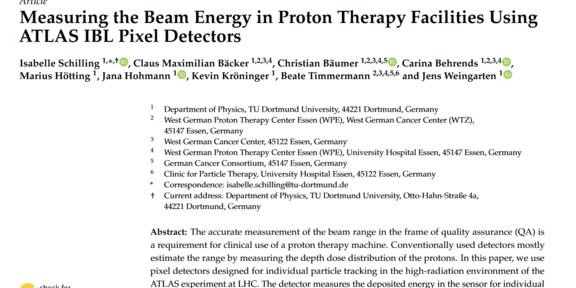News
Measuring the Beam Energy in Proton Therapy Facilities Using ATLAS IBL Pixel Detectors
- Veröffentlichungen

Abstract:
The accurate measurement of the beam range in the frame of quality assurance (QA) is a requirement for clinical use of a proton therapy machine. Conventionally used detectors mostly estimate the range by measuring the depth dose distribution of the protons. In this paper, we use pixel detectors designed for individual particle tracking in the high-radiation environment of the ATLAS experiment at LHC. The detector measures the deposited energy in the sensor for individual protons. Due to the limited dynamic energy range of the readout chip, several ways to measure the proton energy or range are examined. A staircase phantom is placed on the detector to perform an energy calibration relative to the NIST PSTAR stopping power database. In addition, track length measurements are performed using the detector aligned parallel with the beam axis to investigate the Linear Energy Transfer (LET) per pixel along the trajectory of individual protons. In this proof-of- principle study, we show that this radiation hardness detector can successfully be used to determine the initial proton energy for protons impinging on the sensor with an energy below 44 MeV after the range shifters. It becomes clear that an improvement of the energy resolution of the readout chip is required for clinical use.
To the paper:
Instruments 4 (2022) 80
Our other publications on the subject of proton therapy can be found on the corresponding list of publications.



![[Translate to English:] [Translate to English:]](/storages/zentraler_bilderpool/_processed_/a/a/csm_Kopfbild_TU_Dortmund_von_oben_d7307cbbd8.jpg)